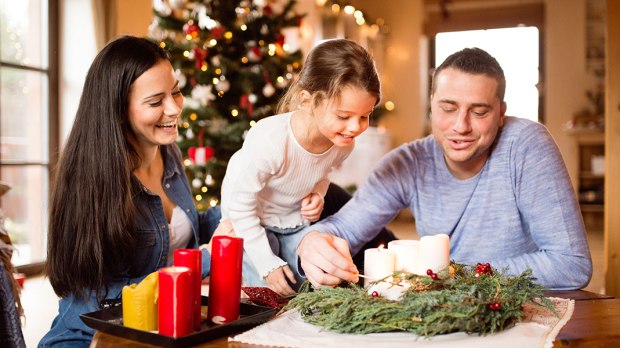When I was a girl, I only heard the word Advent in conjunction with the word calendar. For me, Advent conjured images of chocolates molds hiding behind tiny numbered doors made of cardboard— reindeer heads, Santa faces, etc. Advent meant a giddy countdown to the big prize: the morning when a bedazzled tree would spew dozens of awesome, mall-bought stuff I wanted — which, depending on the year, ranged from neon boy-band paraphernalia to preppy J. Crew loafers.
Advent, however, is a distinct season, designed to help us quiet our hearts and wait in hopeful anticipation of the celebration of Jesus’ birth. “The waiting we are called to do during Advent is not the busy, numbing, frenetic kind of waiting,” Katie Jensen writes on A Sacred Journey, “but the stilling, germinating kind that connects you deeply with the present and your true self.”
I don’t know about you, but Jensen’s description sounds nothing like what I’ve experienced in most of my Decembers. My mailbox fills with news fliers boasting huge bargains. Jingly commercials intrude into my living room and suggest that if I truly loved him or her or them, I’d buy this glimmering thing, this sparkling ring, this gadget unlike any other. News headlines jockey for claims about the latest Starbucks coffee-cup icon. Culturally, December usually feels quite noisy.
But Advent is meant to be a time of silence and listening. In the midst of the cultural noise, Advent is precisely what I need. And yet the first time I attempted to “observe” it, declaring at the start of the season that this December would be different, I flopped. The frenetic energy of secular Christmas railroaded me. By December 25, I did not feel like I’d just observed four weeks of simplicity and quiet and waiting for the divine. I felt like a harried mouse who’d swirled uncontrollably down a drain of consumerism and then got flushed.
I’d failed because I’d tried to do both secular Christmas and liturgical Advent at the same time. Squeezing the secular expectations of Christmas into the regular work weeks had bossed my brain around, and there was no time or space for the quiet and prayerful reflection of Advent.
That year, I realized that in order to deliberately enjoy the sacredness of Advent, I needed to make a plan. If you too feel like the “bustle to buy” is leaving you (and perhaps your wallet) empty, if you too feel thirsty for a true Advent, here are some ideas…
1. Get minimalist with gift-giving
Rethink the cultural pressure to become Jolly Ol’ (Bag-Heavy, Toy-Hauling) St. Nick, and set healthy limitations when it comes to buying gifts. Some families fill only stockings rather than the entire skirt of a giant Frasier Fir. Others eschew material gifts entirely. Rebecca Wiltberger of Kentucky says, “I’ve totally downsized my Christmas gift-giving to a simple gift for the men of my family and a different one for the women. Some years it’s been pajama pants and pretty scarves. This year it’s homemade cookies for the fellas and hair clips/earrings for the ladies.”
Or if you want to individualize your gifts, you might embrace the want-need-wear-read guidelines. Those are the guidelines I’m trying this year, and I’ve been impressed by how quickly they curb my desire to click just one more Disney toy into the virtual Internet basket.
2. Plan ahead
Confession: I love to shop. And I will always want to give every family member an individual gift for Christmas. But hunting for the best deal on a wool-blend sweater feels discordant with sitting in vigil as I hope and long for the fullness of life. Two years ago, I vowed to complete all my family’s Christmas shopping before December 1, and I’ve continued it. This choice has been crucial in helping me cultivate a peaceful, prayerful Advent. If there are certain traditions you know you want to maintain through Christmas, like Christmas card sending, try to get as much of the prep work done before you light your first Advent candle.
3. Let certain traditions go
In order to say yes to Advent’s invitation of deep listening, you’ll need to say no to some of December’s usual busyness. Some families, for instance, decline party invitations until Christmas Eve. Kay Trafton of Vermont says, “I chose ahead of time what traditions were important and which ones were not.” On her not-so-important list: cookie-baking and Christmas-card-sending. She now holds off sending cards until New Year’s. “It was the best decision ever,” she says. “I spent the 12 days after Christmas day leading up to Epiphany to write out six to eight cards per night and really was able to take the time to pray for the people and write personal notes. It no longer felt like a chore, it was something I wanted to do.” Give yourself permission to postpone or entirely eschew certain expectations that don’t speak to your intentions for the season.
4. Try a new (to you) Advent tradition
Shopping and running around less will free up space for other traditions, and Advent has several gems to offer, from Advent wreaths to Jesse trees to Nativity scenes. Melani Daves Moore and her family use this wooden Advent spiral, which combines the daily countdown of the calendar with the candle-lighting of a wreath. When they light a candle each night at dinnertime, they say a devotional together. Other families fill their Advent calendars not with chocolates or other treats but with slips of paper. On them they’ve written prayers, chants, quotes, songs, and even activities they might do together. I like to pull out the toy Nativity scenes for my kids and discover different versions of “O Come, O Come Emmanuel.” (Sufjan Stevens’ is always a good one.)
5. Give something up
Drawn to the idea of fasting during Lent not as a form of self-punishment, but as a way to simplify and make space, I usually give something up during Advent, too. The first year, I fasted from buying anything other than groceries and necessary household goods. This allowed me to focus, not on acquiring new stuff, but on appreciating what was already present in my life. Last year, I gave up social media. I love staying in touch with people, but I wanted to experience a deeper sense of quiet, an intentional turning inward. You might think of something to give up, not as some cruel modern version of a hair shirt, but as a way to draw inward and reflect on your hopes for yourself and for the world.
6. Take something on
When you give something up, you might be struck by how it frees you to embrace something new. What daily practice might enable you to listen to the stirrings of the Spirit? Jenn Giles Kemper, creator of the awesome Sacred Ordinary Days Day Planner, took up daily walks at dusk. Kay Trafton committed to writing in her journal for 10 to 15 minutes a day.
7. Await Christmas … all 12 days of it!
According to the liturgical calendar, Christmas is not just one day but 12. While my family tries to keep the Christmas fever at bay through most of the month, we let it come barreling in on December 24. We celebrate for as many of the 12 days as we can. We loaf and watch movies. We dine on big meals. We visit family we rarely get to see. If you keep the Christmas music and the cookie-eating and the dinner-partying at bay until the evening of December 24, the 12 days of Christmas serve your body and soul as a well-earned feast, one that rejoices not in commercial goods but in love and light.

Read more:
How to celebrate Christmas like G.K. Chesterton

